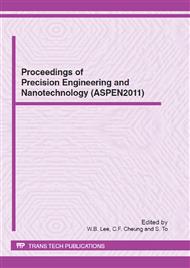p.332
p.337
p.343
p.349
p.355
p.361
p.367
p.373
p.378
Research on Removal Characteristic of the Optical Quartz with Atmospheric Pressure Plasma Jet
Abstract:
The Atmospheric Pressure Plasma Jet (APPJ) is an innovative technology in advanced optics manufacturing; it is a non-contact precision machining method based on the chemical reaction between a reactive neutral radical generated by the plasma and substrate surface atoms for atom-scale material removal. The APPJ involves a complicated process; therefore, the controllability of the technical process was investigated to describe the accuracy of machining efficiency that is the uniformity and repeatability for machining systems, the linearity relation between the removal rates and dwell time. Moreover, the experimental result of the fused quartz removal function variation trend with different processing parameters was discussed. The results of experimentation indicate that the APPJ method has good repeatability within a short dwell time, the removal depth increases with the dwell time and a linearity relation seems appropriate, and the radio frequency (RF) power and the flux of assistant gas oxygen have a great influence on removal efficiency. However, the removal rate remains stable under small perturbation of flux of plasma gas He and reactive gas SF6. And the surface roughness is improved from Ra 9.3nm to Ra 3.7nm.
Info:
Periodical:
Pages:
355-360
Citation:
Online since:
June 2012
Authors:
Price:
Сopyright:
© 2012 Trans Tech Publications Ltd. All Rights Reserved
Share:
Citation:


